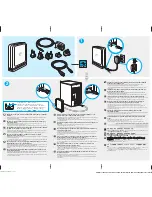
uses a lock manager to coordinate I/O. When one node changes data on a GFS file system,
that change is immediately visible to the other cluster nodes using that file system.
Using Red Hat GFS, you can achieve maximum application uptime through the following
benefits:
• Simplifying your data infrastructure
• Install and patch applications once for the entire cluster.
• Eliminates the need for redundant copies of application data (duplication).
• Enables concurrent read/write access to data by many clients.
• Simplifies backup and disaster recovery (only one file system to back up or recover).
• Maximize the use of storage resources; minimize storage administration costs.
• Manage storage as a whole instead of by partition.
• Decrease overall storage needs by eliminating the need for data replications.
• Scale the cluster seamlessly by adding servers or storage on the fly.
• No more partitioning storage through complicated techniques.
• Add servers to the cluster on the fly by mounting them to the common file system.
Nodes that run Red Hat GFS are configured and managed with Red Hat Cluster Suite
configuration and management tools. Volume management is managed through CLVM (Cluster
Logical Volume Manager). Red Hat GFS provides data sharing among GFS nodes in a Red Hat
cluster. GFS provides a single, consistent view of the file-system name space across the GFS
nodes in a Red Hat cluster. GFS allows applications to install and run without much knowledge
of the underlying storage infrastructure. Also, GFS provides features that are typically required
in enterprise environments, such as quotas, multiple journals, and multipath support.
GFS provides a versatile method of networking storage according to the performance,
scalability, and economic needs of your storage environment. This chapter provides some very
basic, abbreviated information as background to help you understand GFS.
You can deploy GFS in a variety of configurations to suit your needs for performance,
scalability, and economy. For superior performance and scalability, you can deploy GFS in a
cluster that is connected directly to a SAN. For more economical needs, you can deploy GFS in
a cluster that is connected to a LAN with servers that use GNBD (Global Network Block Device)
or to iSCSI (Internet Small Computer System Interface) devices. (For more information about
GNBD, refer to
Section 7, “Global Network Block Device”
.)
The following sections provide examples of how GFS can be deployed to suit your needs for
performance, scalability, and economy:
Chapter 1. Red Hat Cluster Suite Overview
18
Summary of Contents for CLUSTER SUITE FOR ENTERPRISE LINUX 4.7
Page 4: ...Red Hat Cluster Suite Overview ...
Page 6: ...vi ...
Page 19: ...Figure 1 4 Power Fencing Example Fencing 9 ...
Page 21: ...Channel Connections Figure 1 6 Fencing a Node with Dual Power Supplies Fencing 11 ...
Page 34: ...Figure 1 17 Conga LVM Graphical User Interface Chapter 1 Red Hat Cluster Suite Overview 24 ...
Page 49: ...Figure 1 25 luci homebase Tab Figure 1 26 luci cluster Tab Conga 39 ...
Page 76: ...66 ...
Page 78: ...68 ...
















































